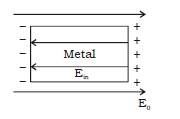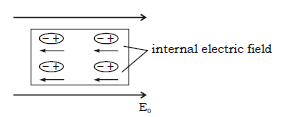(a) Explain, using suitable diagrams, the difference in the behaviour of a
(i) conductor and
(ii) dielectric in the presence of external electric field. Define the terms polarization of a dielectric and write its relation with susceptibility.
(b) A thin metallic spherical shell of radius R carries a charge Q on its surface. A point charge Q/2 is placed at its centre C and another charge +2Q is placed outside the shell at a distance x from the centre as shown in the figure. Find
(i) the force on the charge at the centre of shell and at the point A,
(ii) the electric flux through the shell.
When a conductor like a metal is subjected to external electric field, the electrons experience a force in the opposite direction and they accumulate on the left hand side. A positive charge is therefore induced on the right hand side. This creates on opposite electric field ( Ein ) that balances out (E0). The net electric field inside the conductor becomes zero. 
Here, E0 is the external field and Ein is the internal field created by the re-distribution of electrons inside the metal.
Dielctric: When external electric field is applied, dipoles are created for non-polar dielectrics and in case of polar dielectrics dipoles are aligned. An internal electric field is created such that it reduces the external electric field. The placement of dipoles is as shown in the given figure.

The dipole moment per unit volume of the polarized dielectric is known as the Polarization of a dielectric. It is denoted by P.
The formula for polarization is given by, ![]()
b) i) The electric field inside a spherical shell is zero. Therefore, force on the charge placed at the centre of the shell is zero. For a charge placed at A, shell will behave as if the entire charge Q is placed at the centre of the shell.
Therefore, total charge is, ![]()
Distance from 2Q is ‘x’. 
So, according to Gauss’s law,
Total flux, ![]()
